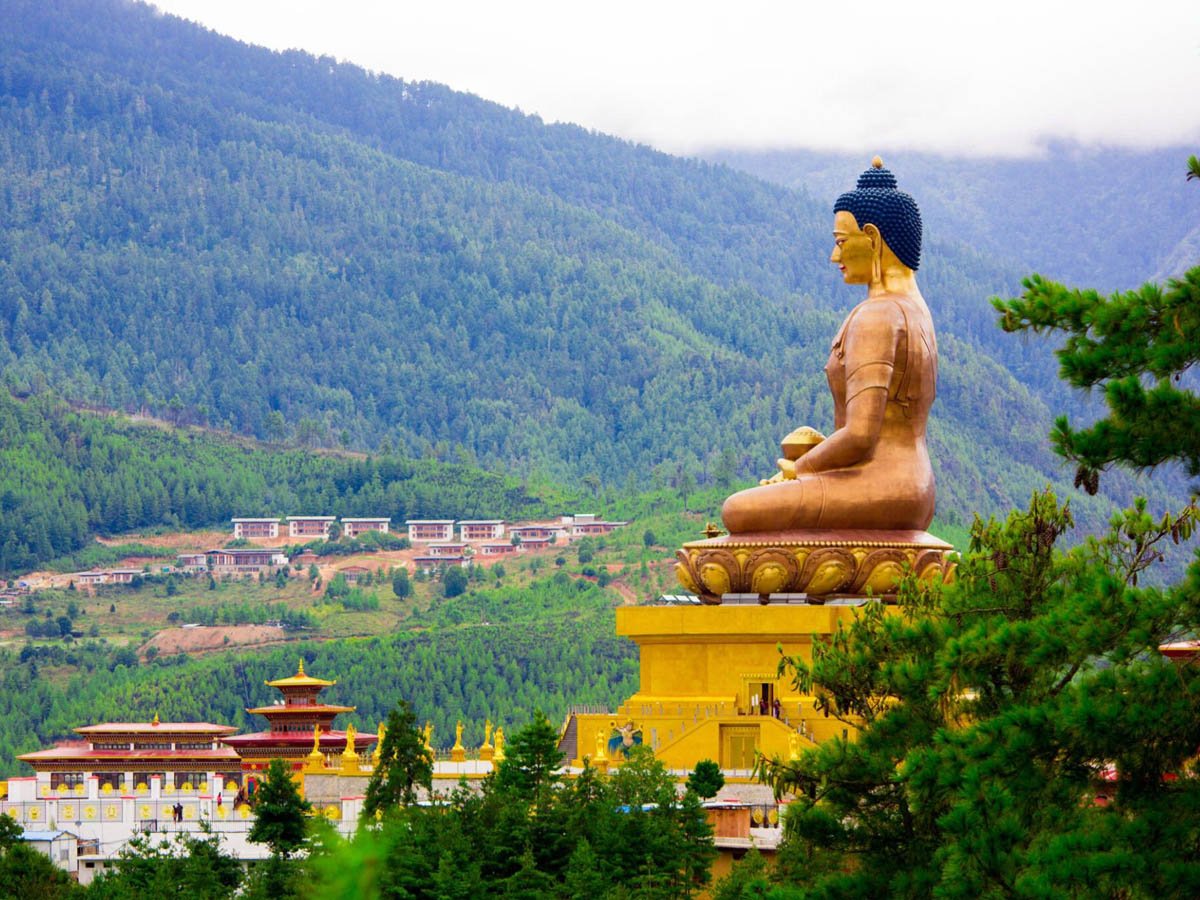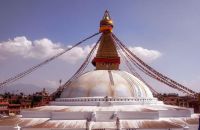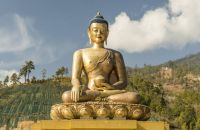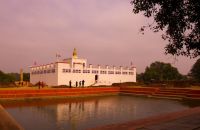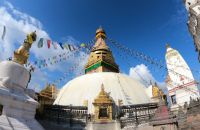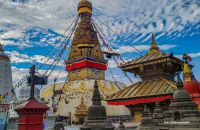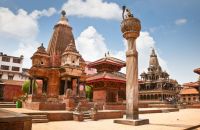Talk with our local travel specialist who can help organize your trip.
Exploring the Himalayas: Bhutan or Nepal? 10 Must-know Differences
Table of Content
If you are an adventure buff and a mountain lover, the Himalayan regions are sure to figure in your bucket list of favorite destinations. While the Himalayas stretch across Pakistan, India, Nepal, Bhutan, and the Tibet Autonomous Region of China, only two countries, Nepal and Bhutan, offer tourists easy access and better facilities in their mountainous areas. The landscape may be equally beautiful in other countries, but there are too many restrictions for outsiders (who wish to visit the mountainous areas), and a lack of infrastructure deters tourists from choosing these destinations.
Nepal and Bhutan score over the other Himalayan countries as they have a streamlined process for tourists, and tourists know what they are in for when they visit these countries. There are scores of tour and trekking agencies that provide assistance to visitors for a fee. There is also no dearth of trained guides, accommodations, and other services that a tourist might need while traveling in remote destination. Moreover, as tourism is a high employment-generating industry in both of these countries, the Nepalese and Bhutanese governments give top priority to the tourism sector. Nepal even has a ‘Tourist Police’ to look after the safety and well-being of tourists visiting Nepal.
While Nepal and Bhutan share a lot of similarities, both being Himalayan nations, there are differences that set them apart. Are you interested in finding out the differences? Let’s scroll and find out.
1. Independent Travel
Bhutan
If you are a person who wants to make your own plans and travel by yourself, Bhutan is not for you. Independent or solo travel is banned in the country. You will have to book your trip with a registered Bhutanese travel agency and have a tour guide with you if you want to travel in Bhutan. According to the Bhutanese government, this rule is in place to save the fragile ecosystem and culture of this small Himalayan country. The government of this tiny nation focuses more on high-quality and low-volume tourism.
Nepal
Nepal is one of the most 'tourist-friendly' countries in the world. Since tourism is one of the top revenue-earning industries in the country, tourists are welcomed with open arms in Nepal. It’s really easy to get a tourist visa and travel across the country. Barring a few remote trekking regions where a permit and a guide are mandatory to enter, one is free to travel the length and breadth of the country without any hassle. However, one should be mindful of the local laws, traditions, and customs while traveling through the country.
2. Connectivity
Bhutan
Bhutan is a landlocked country. You can enter the country either by road or via air. Bhutan shares its border with India, and you can enter this Himalayan kingdom via the Indo-Bhutan border if you are traveling by road.
As far as air connectivity is concerned, Bhutan has only two international airlines operating in its airspace. and both of these airlines are Bhutanese-Druk Air and Bhutan Airlines. Since Bhutan has mountainous terrain, it’s very tricky to fly and operate a large passenger aircraft in its airspace. Paro International Airport, the only international airport in the country, lies in a small valley surrounded by giant mountains on all sides. The pilots of Druk Air and Bhutan Airlines are specially
trained to fly across the mountainous terrain and land at the narrow runway of Paro Airport. India, Thailand, Nepal, Bangladesh, and Singapore are the only countries from where you can fly directly to Bhutan.
You can expect some layovers and overnight stays if you plan to travel to Bhutan from any of the Western countries.
Nepal
Compared to Bhutan, Nepal has better air connectivity. There are many international airlines operating in the country, and one can fly directly to Nepal from any of the major international hubs in Asia and the Gulf region.
While the country has three international airports (in Kathmandu, Pokhara, and Bhairahwa), the Tribhuvan International Airport in the capital city is the only airport with high air traffic. Known as the Gateway to Nepal, the TIA connects Nepal with India, Bangladesh, South Korea, Japan, the UAE, Kuwait, Singapore, China, Sri Lanka, Hong Kong, Thailand, Malaysia, Qatar, Ethiopia, Pakistan, Bhutan, the Tibet Autonomous Region of China, Indonesia, Saudi Arabia, Bahrain, Turkey, etc.
Like Bhutan, Nepal shares its land borders with India and the Tibet Autonomous Region of China. You can easily enter Nepal via the Indo-Nepal land border that’s located in the eastern, southern, and western regions of the country. The most popular overland entry and exit points at the Indo-Nepal border are Kakkarvitta, Bhairahwa-Sunauli, Banbassa-Mahendranagar, Raxaul, etc. From Tibet Autonomous Region, China, you can enter Nepal via Keyrong or Kodari.
3. Mountaineering
Bhutan
The Bhutanese regard the mountains as guardian deities and worship them. Therefore, setting foot on the mountain is a big no-no in Bhutan. While trekking in the foothills is allowed, climbing a mountain is not permitted. There are several 6,000 and 7,000-meter peaks in Bhutan that have remained unclimbed to date. The Ganghar Puensum, the tallest mountain in Bhutan, is one of the highest unclimbed mountains in the world.
Nepal
Nepal is the ultimate destination for mountaineers around the globe. The country has eight of the fourteen highest mountains in the world. Mount Everest (8848m), the highest mountain in the world, lies in Nepal.
Unlike in Tibet, Bhutan, Pakistan, and India, most of the Himalayan peaks in Nepal are open to commercial mountaineering expedition groups. One can easily get a permit and climb a mountain of his or her choice. And there’s a lot to choose from! From 8000-meter giants to 5000-meter peaks, one can choose a mountain according to one’s skill and experience.
There are more than 200 small and big mountains you can choose from. The most popular mountains for climbing in Nepal are Mount Everest, Ama Dablam, Annapurna, Island Peak, MeraPeak, Lobuche, Himlung, Pokalde, and Pisang.
Nepal is the best destination to enjoy fully supported climbing. Foreign climbers can avail themselves of the services of experienced Sherpa mountain guides to guide them through the dangerous terrain and help them with the logistics. From transportation to accommodation and food, all these services are offered for a fee by local agencies that run mountaineering expeditions. Porter service, which is quite helpful in the mountains, is also readily available.
4. Trekking
Bhutan
Bhutan is known for its pristine mountain trails. Trekking and hiking in Bhutan are a must if you are visiting the country. While trekking for multiple days, one can enjoy camping out in the woods. The agency with whom you book the trek will make all the arrangements for your trek.
On the trek, you will have with you a trekking guide, a kitchen crew (to prepare food for you), ponies to carry the ration, tents, and heavy luggage. Each day, you will be woken up by a kitchenhand with a cup of tea and a warm basin of water to wash yourself. Later, breakfast will be served in the dining tent. After breakfast, you will get ready and start your day’s hike. The pitching and dismantling of the tent will be done by the kitchen crew.
After walking for some hours, the trekking team will stop at midday for lunch. The kitchen crew will serve the packed lunch and later continue toward the day’s destination. On reaching the overnight camping spot, tents will be pitched up again, and dinner will be prepared. After dinner, one can take a rest in a one-man or two-man tent.
Nepal
In Nepal, you can experience ‘teahouse trekking’. What is teahouse trekking? Most of the trekking trails in Nepal go through mountainous villages and farms, where accommodation and food are provided at rest stops known as teahouses.
Teahouses are mostly family-run establishments where, usually, a part of the family home is turned into a lodge or restaurant. Amenities at the teahouses tend to be more basic and utilitarian than hotel amenities. A teahouse experience gives you a more homey and cozy feel.
Teahouse trekking tends to be easier, less expensive, and more organized than camping treks. One can enjoy this style of trekking while walking along the Everest, Annapurna, Manaslu, and Langtang regions. In remote areas where the human population is very thin, like the Makalu Barun Valley, Kanchenjunga, and Dhaulagiri, one still has to rely on fully organized camping treks.
5. Religion
Bhutan
Bhutan is a Buddhist country. You can see signs of the country’s belief system as soon as you enter the country. The landscape in Bhutan is decorated with prayer flags, prayer wheels, stupas, monasteries, and huge statues of Lord Buddha and Padmasambhava, or the Second Buddha. There’s a small percentage of Hindus living in the country, but the predominant religion in Bhutan is Buddhism. The Bhutanese follow Tibetan or Vajrayana Buddhism. Monks are revered and respected, and the Je Khenpo, or Chief Abbot of the monks, wields as much power as the most powerful politician.
Bhutanese people are devout Buddhists, and they try to follow Buddhist Dharma in their daily lives. Most of the religious festivals in Bhutan are held at monasteries. People flock to the monasteries to seek blessings from the lamas and observe the rituals and masked dances.
Nepal
Nepal was known as a Hindu kingdom before the advent of democracy in the country. From 2008 onwards, after monarchy was abolished in the country, Nepal became a secular democratic republic. Now people of all faiths are allowed to practice their religions freely. However, the majority of Nepal’s population still remains Hindu.
There are also a large number of Buddhists in the country. The communities living in the high-altitude regions close to Tibet are mostly Buddhists. In Kathmandu, the Newars follow a fusion of Buddhism and Hinduism, which is very interesting. Hinduism and Buddhism have existed in Nepal for thousands of years, and one can find some of the most sacred Hindu and Buddhist shrines in the country. UNESCO has recognized the Pashupatinath Temple, Changu Narayan Temple, BoudhanathStupa, Swoyambhunath, and Lumbini as World Heritage Sites. These are all ancient Hindu and Buddhist pilgrimage sites.
Some indigenous communities have their own belief systems. They usually worship their ancestors and nature. In the far-flung areas of Nepal, ‘shamanism’ is still practiced. The Bon religion, which predates Buddhism and is one of the most ancient religions in the world, is also very much alive in the Upper Dolpo Region and Mustang area. There is a small percentage of Muslims, Christians, and Sikhs living in the country.
Featured Trips
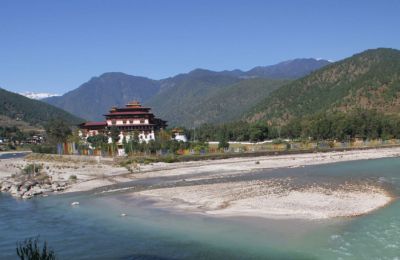
Bhutan Cultural Tour - 5 days
Bhutan Cultural Tour of 5 days lets you discover the rich Bhutanese culture. Visit ancient fortresses and Taktsang Monastery. Enjoy traditional hot stone bath.
Inquire Now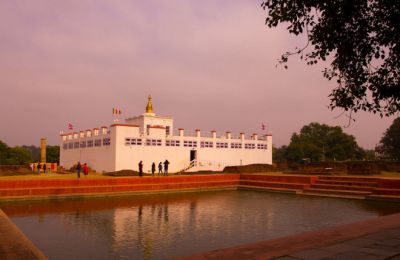
Nepal and Bhutan Buddhist Pilgrimage Tour - 12 days
Bhutan Buddhist Tour from Kathmandu-12 days is a sacred Buddhist Pilgrimage Tour to Nepal and Bhutan. Visit Lumbini, Lord Buddha’s birthplace and Tiger’s Nest.
Inquire NowWhere to travel next?
Get help from our travel specialists for holiday ideas that matches your interests.
6. Culture
Bhutan
Bhutan's culture is rooted in its state religion, which is Vajrayana Buddhism. More than seventy percent of Bhutan’s population is Buddhist. One can find signs of Buddhism everywhere in Bhutan. The hillsides have solitary monasteries, while the landscape is decorated with colorful Buddhist flags, prayer wheels, sparkling white stupas, and ornate chortens.
Bhutan has three major ethnic groups: the Bhotia or Ngalop, Sharchop, and Lhotsampa.
The Ngalops, who are in the majority, follow Mahayana Buddhism. They are found in central and western Bhutan and occupy most of the important government posts. Their language, Dzongkha, is the national language of Bhutan.
The Sharchops occupy eastern Bhutan and practice a mix of Tibetan Buddhism, Bon shamanism, and animism.
The Lhotsampas, who are of Nepalese origin, are found in southern Bhutan and are Hindus. Besides these three ethnic groups, there are also several indigenous groups living in the Indo-Bhutanborder areas.
While Dzongkha is the national language, there are more than 20 different dialects spoken in the country. A good number of Bhutanese also understand English and Hindi.
There is no caste system or gender bias in Bhutanese society. All the people are treated equally, and women receive the same respect as men.
By nature, Bhutanese are very spiritual. Buddhist monks are highly revered and seen as spiritual teachers. The king as well as the royal family are well-loved and quite popular among the citizens.
The Bhutanese people have also kept alive their traditional arts and culture. Traditional songs and dances are still performed by young and old alike. The Zorig Chusum, or the thirteen traditional arts and crafts of Bhutan, have been preserved and practiced widely. Traditional styles of architecture are still very much in use, and it’s not uncommon to find buildings with finely carved traditional wooden windows and doors, even in urban hubs like Thimphu and Paro.
Nepal
Nepal has a diverse culture. Even though the country is home to a large Hindu population, you will find many unique ethnic cultures within the country. As per the National Census of 2021, there are a total of 142 ethnic groups in this tiny country. Each of these groups has its own dialect and customs.
In the high mountain areas of Solu Khumbu, Dolpa, Manaslu, Langtang, and Mustang, you will find people of Tibetan origin who settled in Nepal hundreds of years ago. Sherpas, Bhotias, Tamangs, and Manages all trace their origins to Tibet. They practice a mix of Mahayana Buddhism and Bonshamanism. In the far west region of Nepal are the high caste Khaas Chettris, who have their own language and culture.
The Kathmandu Valley is home to the Newars, who follow a mix of Hinduism and Buddhism. In the middle hills live the Gurungs, Magars, Kiratis (Rais, Limbus, Sunuwars, etc.) and Brahmins. While the lush jungles below the Mahabharat Range are home to the indigenous Tharus, the Terai lowlands bordering the Indian states of Bihar and Uttar Pradesh are home to the Madhesis.
The Hindu society is defined by its caste system. The higher castes enjoy more privileges in society than the lower castes. While the government has outlawed this practice, it is still enforced in rural societies.
There is also a small population of Muslims, Sikhs, and Christians living in this former Hindu country.
Nepal is home to several ancient Hindu and Buddhist shrines. UNESCO has designated seven cultural and historical sites as protected World Heritage Sites. One of the holiest pilgrimage sites for Buddhists is Lumbini, the birthplace of Lord Buddha, which is located in Nepal.
7. Form of Government
Bhutan
Since 2008, Bhutan has been a democratic constitutional monarchy. The king of Bhutan is the head of the state, but the Council of ministers, or Lhengye Zhuntshog, headed by the country’s prime minister, holds the executive power.
The Bhutanese Parliament is divided into the Upper House (National Council) and the Lower House (National Assembly). The country has a multi-party system, and elections for the national assembly are held every five years. The party that wins the most votes gets to nominate the Prime Minister.
The legal system in the country is based on legal codes drawn by Zhabdrung Ngawang Namgyal (the unifier of Bhutan) in the seventeenth century and the common laws of the Anglo-Indian government.
Apart from the three main branches of government—executive, legislative, and judicial—there is also a Monastic Affairs Commission, headed by the Chief Abbot, or Je Khenpo. The JeKhenpo is very influential in Bhutan and acts as the chief advisor to the King.
Nepal
Nepal was known as the last Hindu Kingdom before the country transformed into a federal democratic republic after a bloody civil war. The decade-long conflict between Maoist insurgents and the royal army resulted in the abolition of monarchy and the setting up of a democratic government led by Maoist leaders. This was in 2008.
Now this former Himalayan kingdom is a democratic republic where the head of state is the president and the prime minister is the head of the ruling party that runs the government. Nepal has a multi-party system where members of the constituent assembly are elected by the people.
Unlike in Bhutan, where the king is still the ceremonial head, the king and the royal family of Nepal have been stripped of their powers, and they are now counted as common citizens. They have no say in the government or the political affairs of the country.
8. Topography
Bhutan
Bhutan, being a Himalayan country, is covered by hills and mountains. The cities and towns in Bhutan are usually located in wide valleys surrounded by mountains and hills. Wherever you travel in Bhutan, you will be welcomed by lush, green, forested hills. Bhutan is one of the few countries in the world that is carbon-negative. More than seventy percent of its total land mass is covered by forests, resulting in the country producing more oxygen than carbon dioxide.
Towards the north of the country are the high Himalayan ranges that remain snowbound throughout the year. Below the mountains are the highlands, characterized by alpine meadows and a cold climate. The deep valleys connected by mountain passes are the most populous regions of the country. South Bhutan, which lies close to India, has a tropical climate and the most fertile land in the kingdom.
Nepal
While Nepal and Bhutan both lie within the Himalayan region, Nepal has a much more diverse topography. Towards the north of the country are the high mountains, which rise to a height of 8000 and 7000 meters. Below these mountains are the middle hills, where most of the country’s trekking trails wind through.
The hills taper down in the south to form the Terai Plains, where the elevation reaches as low as 70 meters above sea level. The highest elevation in Nepal is 8848 meters, which is the height of Mount Everest. The difference in elevations is largely responsible for the country’s diverse landscape and climatic conditions. One can explore cold arctic deserts as well as lush tropical forests and humid plains within Nepal.
In addition, Nepal also has a mountain desert area in Mustang and parts of the Manaslu region. These areas fall under the Trans-Himalayan Region and receive very little or no rainfall annually. Surrounded by barren brown and red hills these regions resemble the arid mountain deserts of the Tibetan plateau and the Ladakh region in India.
9. General Prosperity
Bhutan
Bhutan has a small population, which relies mostly on agriculture and tourism. Compared to Nepal, Bhutanese citizens enjoy better welfare facilities from the government. In Bhutan, general healthcare and education are provided free of charge by the government. There are also special incentives for the weak and infirm members of society to make their lives better.
Instead of GDP, the Bhutanese government uses the Gross Happiness Index to measure its prosperity. Instead of material wealth, the country uses the contentment and happiness of its citizens as a yardstick to measure its prosperity. Bhutan is the only country in the world that follows this system.
When you are traveling in Bhutan, you will not find beggars or homeless people. The king of Bhutan apparently provides land and housing for any Bhutanese citizen who requests the king's help. While the Bhutanese people are not filthy rich, they are not living in extreme poverty. People have enough to sustain and feed themselves.
Nepal
Nepal is counted as a third-world country. There is poverty in the country. Unlike in Bhutan, one will come across beggars and homeless people as one enters Nepal. The major income-generating industries in Nepal are agriculture, the textile industry, the food and beverage industry, and tourism. The government of Nepal also receives a huge amount from overseas remittances. Many young Nepalese prefer to head overseas for career opportunities as they feel that Nepal doesn’t offer enough opportunities to sustain themselves. The distribution of wealth in the country is uneven, with about fifteen percent of its total population living below the poverty line (as per the Economic Survey 2022/23).
10. Festivals
Bhutan
As Bhutan is a Buddhist country, the major festivals celebrated in the country are related to Buddhism. Bhutan observes a festival almost every month. These festivals are dedicated mostly to Buddhist saints and deities. Most of the celebrations take place in the large courtyards of monasteries, with people from all walks of life, rich and poor, attending the festivities.
Tsechhu is one of the unique festivals celebrated in Bhutan. These Tsechhus are celebrated at different places at different times of the year. Dedicated to Guru Rinpoche, or Padmasambhava (also known as the Second Buddha), who introduced Buddhism to Bhutan and Tibet, the festival is marked with masked dances, or chams, and religious skits performed by the monks. There is alsounvielingof hugethankas (scrollpaintings) that cover large areas. The most popular Tsechhus are those celebrated at Paro, Thimphu, Punakha, Gangtey and Wangdue Phodrang.
Other important festivals celebrated in Bhutan include the Losar, or the Tibetan New Year; JambayLakhang Drup; and Punakha Drubchen. Some of the festivals that are held to promote tourism in the country are the Black-Necked Crane Festival in Gangtey, the Matsutake Mushroom Festival in Thimphu and Ura Valley, the Jomolhari Mountain Festival at the foot of the Jomolhari Mountain, the Haa Summer Festival in Haa Valley, and the Royal Highland Festival in Laya.
Nepal
The biggest festival celebrated in Nepal is the Hindu festival of Dashain. The festival, which is celebrated in autumn, is dedicated to the Hindu goddess Durga and her manifestations. Also known as Bijaya Dashami, the nine days of the festival are dedicated to the different manifestations of the goddess Durga, who fought the demons and emerged victorious. On the tenth day, people celebrate the victory of good over evil by visiting family members and seeking blessings from elders. The nation remains closed for five days during this festival as people visit their villages and ancestral homes to observe this festival.
Another important Hindu festival celebrated in Nepal is Tihar or Diwali. Also known as the festival of lights, this is an important festival for business houses as the festival is dedicated to Laxmi, the goddess of wealth and prosperity. The streets and homes are cleaned and decorated with colorful lights to welcome the goddess.
In the mountainous areas, ethnic groups like the Sherpas, Manages, Bhotias, and Kirats celebrate their own unique festivals. In the Khumbu, or Everest Region, the most important festival is Mani Rimdu. The festival is only observed at the monasteries of Tengboche, Chiwong, and Thame. Dumji is another colorful festival of the Sherpas. This festival is celebrated in Namche Bazaar, Tengboche, Junbesi Khumjung, and Pangboche. This is a community festival where a family from a village is chosen to bear the cost of the festivities.
Tiji is a vibrant festival celebrated in Upper Mustang, where one can witness colorful masked dances. Yartung is a boisterous horse racing festival celebrated in Mustang. This festival marks the advent of autumn. Other fascinating Buddhist festivals celebrated in the mountains of Nepal include Gyalpo Losar, Dhekap, Mitha, Lha Phewa, the Shey Festival, and Badhe.
In the hills of eastern Nepal, the Kirati communities worship nature. Their important festivals are Ubhauli and Udhauli, which mark the harvesting season and the migration of birds and animals. While Ubhauli marks the advent of the warm summer season, Udhauli signifies the onset of the cold season and the migration of birds towards the lower and warmer areas.
Mithila people living in the Terai area close to the Indian states of Bihar and Uttar Pradesh celebrateChatth Puja, which is dedicated to Surya, or the Hindu Sun god.
The Newars of Kathmandu Valley also have their own unique festivals. They worship Hindu as well as Buddhist deities, and their festivities are marked by chariot-pulling street festivals or rath jatras. The most important jatras include the Indra Jatra and Hadigaun Jatra celebrated in Kathmandu, the Rato Machindaranth Jatra celebrated in Patan, and the Bisket Jatra celebrated in Bhaktapur. The festivities last for several days, with the locals coming out in the streets and pulling the chariots of the deities while singing and dancing.
Featured Trips
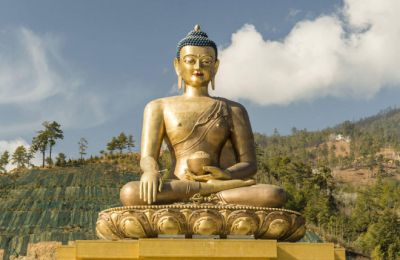
Bhutan Heritage Tour - 8 days
Bhutan Heritage Tour lets you explore centuries-old dzongs and Lakhangs built by Bhutanese kings and spiritual leaders. Take this Bhutan Heritage Tour and journey across the cultural hotspots of Bhutan, a fascinating Himalayan kingdom.
Inquire Now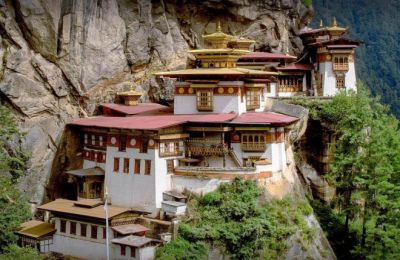
Nepal and Bhutan Tour - 9 days
Experience the beauty and culture of Nepal and Bhutan with our exclusive tour package for 2024/2025. Book now and create unforgettable memories!
Inquire NowWhere to travel next?
Get help from our travel specialists for holiday ideas that matches your interests.
Bhutan’s Sustainable Development Fee
Besides these ten differences, there is another notable difference between these two countries. Bhutan charges a per-day fee to tourists visiting the country. Known as the Sustainable Development Fee, one has to shell out USD 100 per day (USD 65 for Indians, Bangladeshis and Maldivians) to visit the country. The amount raised from SDF goes towards funding the free healthcare and educational schemes in the country.
In Nepal, a tourist doesn’t have to pay this kind of daily fee to tour the country. Except in some remote trekking areas where entry is restricted (for example, Tsum Valley and Upper Mustang, where one has to pay a restricted area permit fee), tourists are free to explore the country.
Air Pollution in Nepal
Another difference one will notice between these countries is pollution. Bhutan is pollution-free, and it has some of the purest air quality in the world. This tiny Himalayan country is doing a lot to protect the environment. There is also less or zero noise pollution in Bhutanese cities. There are no traffic lights in the streets, and there are hardly any incidents of road rage or traffic jams.
Nepal’s capital, Kathmandu, has one of the poorest air qualities in the world. The air pollution in Kathmandu has led to a rise in respiratory illnesses in children and elderly people. The hills and mountains of Nepal have a much calmer and more tranquil vibe. Thus, tourists generally prefer to head to the mountains instead of exploring the cities.
Do tourists get scammed?
While traveling in Bhutan, you won’t have to worry about being scammed, as a local guide will be with you throughout your stay in the country. Moreover, most rates of goods sold in shops are government-regulated, and shopkeepers do follow the law. You will not encounter touts or hustlers while touring tourist attractions, and this will make your travel experience more enjoyable and peaceful.
Nepal, like all major tourist destinations in the world, has its share of scammers and touts who try to scam tourists. But these types of people can only be found in the cities’ tourist hubs (Thamel and Lakeside). One needs to be on guard while visiting the tourist hubs, especially if traveling alone. However, one need not worry about being physically harmed or mugged, as Nepalese are not violent people. People generally help tourists and are kind to them. Many foreigners find Nepalese locals friendly, hospitable, and extremely kind.
Why should you visit Bhutan?
Bhutan should be on your list of must-visit destinations if
- You crave peace and quiet and want to disconnect digitally from the outside world
- You seek a unique cultural experience
- You want to find out what life's like in a Himalayan kingdom (Bhutan has a democratic constitutional monarchy where the king and queen are ceremonial heads)
- Nature works as a balm for you
- Buddhist art and culture piques your interest
- You want to spend your holiday at a spa resort, restoring your inner balance through yoga and meditation
Why should you visit Nepal?
Nepal is the perfect destination for you if
- You love the mountains and the outdoors
- You are into adventure activities like trekking, mountaineering, whitewater rafting, rock climbing, mountain biking, etc.
- You want to trek across diverse terrain
- You seek to discover ancient history and culture
- You are intrigued by Hindu temples and Buddhist monasteries
- You want to go on a Hindu or Buddhist pilgrimage
- Visiting UNESCO World Heritage Sites is on your bucket list
Visa
Bhutan
A Bhutan visa can be obtained online, or the agency with whom you book your tour will arrange it for you. The cost of the Bhutan visa is USD 40 and is non-refundable. You will have to pay the Sustainable Development Fee along with the visa fee in order to get the Bhutan visa.
Nepal
Tourists can easily get a Nepal visa on arrival. The international airport in Kathmandu has electronic kiosks and manned counters where you can fill out the visa form and obtain your Nepal visa. To get the visa, you need to pay the required fee and submit a form with your personal details, passport photograph, and contact information. Your passport should have six months of validity and two blank pages. You can also apply for a Nepal visa from any of the Nepalese diplomatic missions stationed abroad.
The nationals of some strife-torn African and Middle-Eastern countries cannot avail of the ‘Visa on arrival’ facility. They will have to contact the Nepalese Embassy or Consulate stationed in their country to apply for a tourist visa.
Food
Both Nepal and Bhutan use rice as their staple dish. As far as variety is concerned, Nepal offers a more diverse gastronomic experience. Bhutanese use a lot of chilies and cheese in their food. EmaDatshi, which is a spicy chili and yak cheese stew, is the national dish of Bhutan. The Bhutanese also eat a lot of meat (pork, chicken, and beef) and mushrooms seasoned with native herbs.
Nepalese food differs from region to region. While the staple Nepali dish is ‘dal, bhat, tarkari (rice, lentil soup, and vegetable or meat curry), each region has its own special dish. The Newars, who inhabit the Kathmandu Valley, have their own traditional cuisine. The Newari cuisine has more than two hundred dishes that include items made from buffalo meat and organs, chicken, duck meat, different grains and pulses, dried fish, and dairy.
The Thakkalis living in the Thak Khola region of Mustang have their own unique cuisine where buckwheat, barley, millet, and Szechuan pepper are liberally used. In the high-altitude mountain settlements, tsampa, or roasted barley flour, provides much-needed nutrition to the mountain folks. In addition, Su Chya, or salted butter tea, Sherpa stew, thukpa, momo, or dumplings, Kur, or Tibetan bread, Shyaphale, Rilduk, and Chyang are also prepared and relished in the high mountain areas. The Tharus living in the Terai belt eat proteins that are sourced from the forest, rivers and the fields like snails game meat and river fish.
Apart from the local dishes, the cities of Kathmandu and Pokhara offer a wide variety of international flavors. There are plenty of restaurants offering authentic Indian, Italian, Japanese, Chinese, Vietnamese, and Korean dishes. There are bakeries and confectionaries offering freshly baked French breads and pastries. For Muslim tourists, there are a few Halal restaurants where one can enjoy Halal dishes.
Conclusion
Exploring the Himalayas, especially Bhutan and Nepal, can be a joyful experience. Both of these destinations are affordable and have so much to offer. The people are warm and friendly and welcome outsiders. Their unique cultures offer a window into their wonderful lives, rooted in Buddhist and Hindu spiritualism and a respect for nature. Sheltered by giant Himalayan mountains, both of these countries have preserved their age-old customs and traditions. In this modern day and age where people are forgetting and discarding the cultures of their ancestors, the thriving ancient cultures in Nepal and Bhutan are indeed a rarity.
So which country should you choose? Nepal or Bhutan? I recommend you travel to both of these countries, as both Nepal and Bhutan are equally fascinating and worth visiting. Both of these Himalayan destinations offer an enriching travel experience. Walking beneath the gigantic mountains surrounded by pure nature is bound to transform you and change your perspective of the world.
- Written by: Naba Raj Amgai
Updated: Feb, 22, 2024

